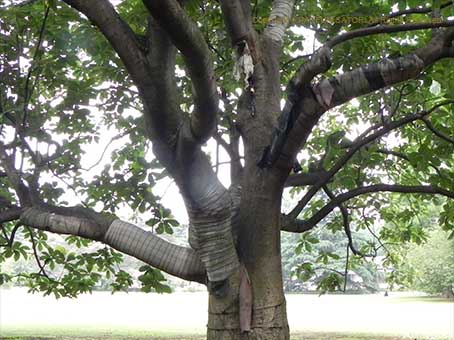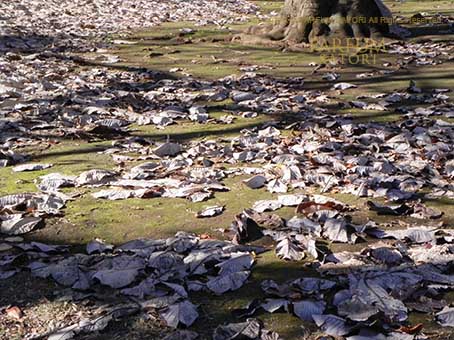
Hoh-no-ki's scientific name is Magnolia obovata thunb.
"Obovata" is from the Latin ob- and ovum, referring to the inversed egg-shaped leaves.
Magnolia has huge oval leaves that are 30 to 40 cm long. You can see its largeness if you compare them to other leaves. The leaves and flowers are one of the largest and native to Japan.
Spring leaves are soft and silky and smooth.

This Magnolia tree in Shinjuku Gyoen is quite old. It has many cuts and scratches.
Nevertheless, every year in May, it blooms profusely with large flowers on the end of its branches stretching in the air.
100 to 200 (or more) flowers constantly bloom for 3 weeks or so, though their life is short.
A fruity note at the beginning and a lactonic scent in the end blend into one another
and hang around the tree. At times, a blow of early summer wind carries their fragrance
to a long distance.

There are almost no visitors in this park during the rainy season.
I would sometimes stand under this tree for a long time, holding up my umbrella in the rain.
It's hard to find a place for adult women to cry.
I love this tree. I love it when it blooms. I love it when it casts its shadow on the ground, blocking the strong summer sunlight. I love to see its dry grayish fallen leaves covering the ground.

See? Look how large they are, compared to the leaves of the cherry blossoms.
All the leaves fall from the tree, most of them returning to the soil, some being
carried away by the wind and absorbed by other plants.

Giant trees of over 100 or 1,000 years old, they live much longer than humans.
Every year they sprout, bloom, perish and return to the soil.
It takes one year to complete life cycle of birth, growth and death. And the life goes on.
Spring, summer, autumn and winter. The cycle of the four seasons of the year.
We continue to grow and change living through many seasons and years.